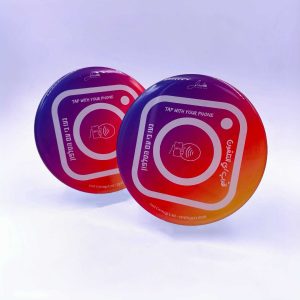Custom NFC tags
Buy Custom NFC Tags
-
Offer Good Price
-
Manufacturing various NFC tags
- 1-year quality warranty
- Free return

Use Custom NFC Tags to Create a Unique and Effective Brand and Marketing Campaign
Custom NFC tags are a powerful and innovative tool that can help you create a unique and effective brand and marketing campaign. They can help you:
– Make your NFC tags stand out with your logo, design, color, shape, size, and content.
– Choose a professional and reliable RFID tag maker that can provide you with high-quality custom NFC tags at competitive prices and fast delivery.
– Unleash your creativity and imagination to use custom NFC tags for various applications and scenarios that can benefit your brand and marketing.
– Boost your brand and marketing results with the advantages and features of custom NFC tags such as innovation, convenience, versatility, interactivity, etc.
If you are interested in using NFC tags for your brand and marketing campaign, please contact us today. We are a professional and reliable RFID tag maker that can help you create high-quality custom NFC tags for your needs. We offer various types of NFC tags for different purposes at reasonable prices and fast delivery. We also offer excellent customer service and support for our custom NFC tags. We guarantee 100% satisfaction and quality for our custom NFC tag.
Don’t miss this opportunity to use custom NFC tags to boost your brand and marketing results. Contact us today and get started with your NFC tag project. We look forward to hearing from you soon.
RFID Tag Maker can Custom NFC tags in a variety of shapes, sizes and chip types to meet your specific needs. Click”Get Free sample” above and share specific details regarding your project. The RFID Tag Maker team will contact you with any questions and quotes will be based on the specific product configuration, quantity, delivery times and other services including encoding and printing that you require.
For budgetary purposes, typical prices range from $0.23 to $1.0 depending on quantity, customizations, and market conditions. A quote will be created once the specific chip type and all customizations are known.
Popular NFC Chips
NXP’s NTAG family of chips are by far the most common chips used in mobile applications. Basic details are listed here, and a breakdown of each feature and chip is listed below.
| Chip | Memory | User Memory | Max URL | Scan Counter | Password | Auth | |
|---|---|---|---|---|---|---|---|
| MIFARE Ultralight | 64 | 48 | 40 | ||||
| MIFARE Ultralight EV1 (80byte) | 80 | 48 | 40 | Yes | |||
| MIFARE Ultralight EV1 (164byte) | 164 | 128 | 120 | Yes | |||
| NTAG203(discontinued) | 168 | 144 | 136* | ||||
| NTAG210µ | 64 | 48 | 40 | ||||
| NTAG210 | 80 | 48 | 40 | Yes | |||
| NTAG213 | 180 | 144 | 136* | Yes | Yes | ||
| NTAG215 | 540 | 504 | 492 | Yes | Yes | ||
| NTAG216 | 924 | 888 | 854 | Yes | Yes | ||
| NTAG424 | – | 256** | 240 | Yes | Yes | Yes | |
| NTAG213 TT | tbc | tbc | tbc | Yes | Yes | ||
| ST25TN01K | 256 | 160 | 152 | ||||
| ST25TN512 | 256 | 64 | 56 | ||||
| NTAG426Q | – | 916** | – | Yes | Yes | Yes | |
| NTAG223 | – | 144** | – | Yes | Yes | Yes | |
| NTAG224 | – | 207** | – | Yes | Yes | Yes |












